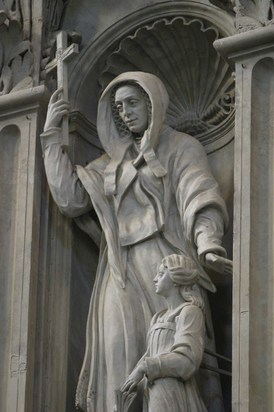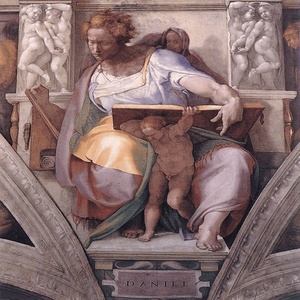Tag: saint
Saint Alphonsus Liguori

Image via Wikipedia
Saint Alphonsus, born in 1696, a lawyer by 20. ordained priest in 1726, a founder of a religious congregation of priests and brothers, a bishop, an author and a Doctor of the Church, is remembered today’s at Mass.
Perhaps he’s best known for founding the Congregation of the Most Holy Redeemer – better known as the Redemptorists – in 1732 with official papal approval in 1749. The Redemptorists were did missionary work, taught catechism and gave retreats; they concentrated mostly on the country side for their spiritual labors.
It is true that you can’t force a sacrament on someone and that one’s perfect freedom has to be respected, history tells us that Alphonsus was forced against his own will, to be the bishop of Naples’ small Diocese of St. Agatha in 1762, a ministry he exercised for 13 years. During these years he set about correcting liturgical abuses and other such things, reformed the seminary, sent priests to be missionaries, and helped the poor.
On August 1, 1787, at Pagani, Alphonsus Liguori died at mid-day, as the bells were calling the faithful to pray the Angelus.
In 1839, Alphonsus was canonized and and the Magisterium declared him to be a Doctor of the Church in 1871.
As an author, Alphonsus published more than 100 books, including The Glories of Mary, Preparation for Death, and The Passion and the Death of Jesus Christ.
The Redemptorists have a US province.
Saints Ann and Joachim
O Lord, God of
our Fathers, who bestowed on Saints Joachim and Anne this grace, that of them should
be born the Mother of your incarnate Son, grant, through the prayers of both,
that we may attain the salvation you have promised to your people.
Today’s the liturgical memorial of Saints Ann and Joachim, the parents of Mary, the Mother of God and the grandparents of Jesus. In the simplest understanding is that the Church remembers the Lord’s family members. But let’s move beyond this initial thought and look more closely at the collect noted above: the priest prays that through the intercession of Ann and Joachim salvation may be given to us as promised to God’s people.
Historically we know that Ann and Joachim existed; their biographies are unknown to us. What we do learn from sacred Tradition is the approach Ann and Joachim took to the action of the Divine Majesty in their lives. They trusted in God.
The Church brings to our awareness the lines of grace in a historical fashion. The prayer reminds us of Jesus’ humanity and the promise God the Father made to His people: His Presence among us; an offer for salvation. This feast is clearly interpreted for us in the first reading from Sirach and the psalm. There we hear the beautiful words of promise, of remembrance, of relationship.
Prophet Daniel
Nativity of Saint John the Baptist
St Norbert of Xanten
First a Benedictine monk then a founder of an order of canons to live under the Rule of St Augustine, the Order of Premontre, the noble Norbert sought to fight heresy, to promote true devotion to the Blessed Sacrament, to dispel spiritual, to defend the papacy, work for peace, to end human indifference and reconciliation among family.
One of the key features to Saint Norbert’s spiritual life and apostolic work was his total reliance on the Lord to direct everything. He realized that his own skill set was insufficient to do much with Christ. That’s why a true Norbertine vocation is lived with one’s face turn toward the Eucharistic Lord and his feet and hands sustaining the Church.
Norbert was also the archbishop of Magdeburg. As archbishop, Norbert collaborated with the likes of Saints Bernard and Hugh in the reformation of the clergy and effecting ecclesial unity. Norbert died on this date in 1134.
Through Saint Norbert’s inspiration and prayer may we be servants of the Church outstanding in prayer, pastoral zeal and love for the people of God.
Saint Lucy Filippini
 This is the wise virgin who has chosen the better part; she listened to the word of the Lord and treasured it in her heart.
This is the wise virgin who has chosen the better part; she listened to the word of the Lord and treasured it in her heart.
Who are saints? They are “Flesh and Blood Human Beings”
As Father Gabriel B. O’Donnell reminds, being a saint doesn’t mean that you are divested of your own personality, to have intimacy with God doesn’t mean you change who you are as a person. Domincan Father Gabriel O’Donnell is currently the academic dean at the Dominican House of Studies, Washington, DC.
Saint Catherine of Siena
 Today is a fitting day to pray for the Holy Father, Pope Benedict. Saint Catherine was a woman of great courage and vision who promoted unity with the Church. Her crusade was a crusade for souls, for the salvation of many to heart of Christ through the ministry of Christ’s vicar, the Pope. That today we are still in the Easter Octave, Siena’s feast is not being observed except in places of the Order of Preachers. We are doing so today the Church of Saint Catherine of Siena, NYC, with a Octave Mass of Easter with elements of Saint Catherine’s Mass parts intelligently placed; Holy Mass is being celebrated by the Most Rev’d Octavio Cisneros, an auxiliary bishop of Brooklyn.
Today is a fitting day to pray for the Holy Father, Pope Benedict. Saint Catherine was a woman of great courage and vision who promoted unity with the Church. Her crusade was a crusade for souls, for the salvation of many to heart of Christ through the ministry of Christ’s vicar, the Pope. That today we are still in the Easter Octave, Siena’s feast is not being observed except in places of the Order of Preachers. We are doing so today the Church of Saint Catherine of Siena, NYC, with a Octave Mass of Easter with elements of Saint Catherine’s Mass parts intelligently placed; Holy Mass is being celebrated by the Most Rev’d Octavio Cisneros, an auxiliary bishop of Brooklyn.Who is St George?
How can anyone not like Saint George’s story? Whatever happened to the real cult of Saint George? Does the saint have contemporary relevance for us today? What witness does he offer the “post-modern” people we purport to be? Do we still struggle against Satan, the evil one, the great tempter? How do deal with the noontime devil that seeks to divide us from a filial relationship with God? Jesuit Father George Nedungatt, professor emeritus of the Pontifical Oriental Institute (Rome) wrote an essay “Saint George without the Dragon” explaining contemporary –at least since Vatican II– Church’s remembrance of and prayerful reliance on, the Lord’s dragon slayer. As the summary of the article says, “The post-conciliar reform has entered the liturgical celebration of St. George [on April 23] amidst the facultative memoirs, attributing the historical date of his martyrdom in Lydda circa 303. It follows the protest, both by those who have chosen St. George as patron and, and for opposing reasons, by those who deny the killing of the dragon by the saint. To shed light on the issue, the article distinguishes between the current liturgical (the cult certificated since ancient time on the saint’s tomb), and the literary tendency, (legends based on his figure as a symbol of the struggle against the forces of evil).” You can read about Saint George in La Civiltà Cattolica (3859, 2011, II, pp. 20-29).






